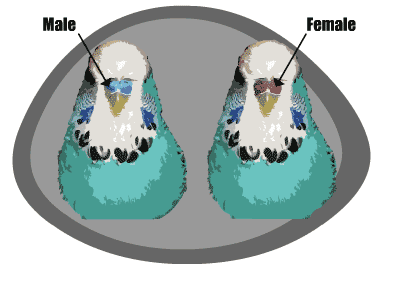Sexing Your Mature Budgies
Budgies are
sexually dimorphic, which means they can be sexed visually. But
like most parrots that can be sexed visually, they need time to
exhibit their gender traits.
Sexing a budgie
is not difficult and can easily be done through their nose (cere).
If your mature budgie has a brown nose then you have a female. If
your mature budgie has a blue nose then you have male. Keep in
mind the budgie’s nose will change coloring around 8 months;
sometimes sooner. It can be difficult sexing a young budgie
because all have pink ceres. The diagram below shows two adult
budgies with different cere colors.

Sexing Budgies
Through Their Behavior
If you are
eager to determine the sex of your parakeet here are few behavior
characteristics that may help . Remember this is not a definite
way because sometimes budgies can act one way and this could give
you false notions about your bird’s sex. If you must know your
budgie’s sex, the most accurate and reliable way is through DNA
testing. Kits are affordable and results will be returned in a
few weeks or days depending on the company you choose.
Males: A
male budgie will bob its head often while it sings and moves back
and forth on its perch. This is their mating dance and many young
males will practice this behavior.
Females:
A female budgie will sing less or cannot make vocal variations
like the males. Instead, they will mostly make loud chips and
calls; very rarely will they sing. A female budgie can show signs
of being territorial by becoming bossy towards their owners or
other birds. |

